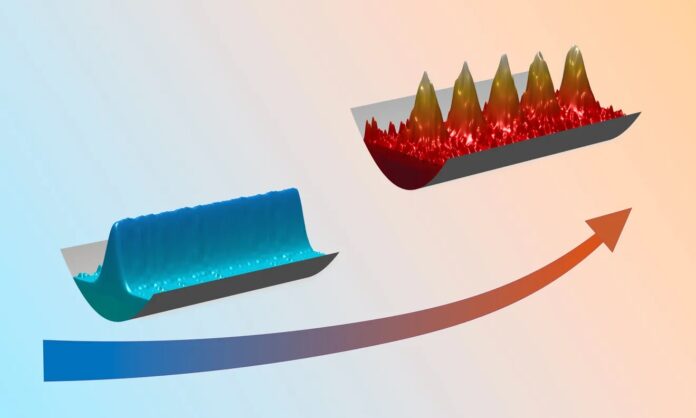The thermal motion of particles increases as a material’s temperature is raised. Such an increase in thermal energy frequently causes a solid to melt into a liquid, which ultimately causes the liquid to vaporize into a gaseous phase of matter.
However, in the quantum world, the opposite happens. In a joint effort, an experimental team led by Francesca Ferlaino in Innsbruck, Austria, and a theoretical team led by Thomas Pohl in Aarhus, Denmark, show how a quantum liquid forms supersolid structures by heating.
A supersolid is an exotic phase of matter in which particles develop regular spatial order and simultaneously support the frictionless flow of a superfluid. Having evaded experimental verification for several decades, supersolidity can now be observed in Bose–Einstein condensates of ultracold atoms with finite-range interactions.
Three research teams, including one led by Francesca Ferlaino from the Department of Experimental Physics at the University of Innsbruck and the AW Institute for Quantum Optics and Quantum Information (IQOQI) in Innsbruck, were able to conclusively prove this state for the first time in ultracold quantum gases in 2019.
In 2021, Francesca Ferlaino’s team studied the life cycle of supersolid states in a dipolar gas of dysprosium atoms. They observed something unexpected: The data suggested that temperature rise promotes the formation of supersolid structures.
Claudia Politi of Francesca Ferlaino’s team said, “This surprising behavior was an important boost to theory, which had previously paid little attention to thermal fluctuations in this context.”
The Innsbruck scientists, in collaboration with the Danish theoretical group led by Thomas Pohl, explored the effect of the thermal function. They developed a theoretical model that can explain the experimental results and underlined the thesis that heating the quantum liquid can lead to the formation of a quantum crystal. The theoretical model shows that as the temperature rises, these structures can form more easily.
Francesca Ferlaino said, “With the new model, we now have a phase diagram for the first time that shows the formation of a supersolid state as a function of temperature. The surprising behavior, which contradicts our everyday observation, arises from the anisotropic nature of the dipole-dipole interaction of the strongly magnetic atoms of dysprosium.”
The study could help better understand supersolid states of matter.
Journal Reference:
- Heating a quantum dipolar fluid into a solid. J. Sanchez-Baena, Claudia Politi, F. Maucher, Francesca Ferlaino, and T. Pohl. Nature Communications 14, 1868 (2023) (Open Access) DOI: 10.1038/s41467-023-37207-3
